The navel piercing is an iconic and classic statement of confidence and personal style. When performed correctly and adorned with beautiful jewellery, it’s a stunning accent that celebrates the form of the body. At Pink Tatpier, London’s premier piercing and tattoo studio, we believe a beautiful, long-lasting navel piercing begins with a professional anatomy assessment, is executed with absolute precision, and is supported by a lifetime of expert advice.
Unfortunately, navel piercings have a reputation for being problematic, but this is almost always due to improper placement on unsuitable anatomy by inexperienced piercers. The truth is, a successful navel piercing is a specialist skill. Our approach is different. We prioritise your body’s unique shape to determine the right technique and jewellery for you, ensuring a safe and successful result.
Discover if a traditional or a modern “floating” navel piercing is right for you, get a transparent price quote, and book your appointment online with our expert piercers who put your safety first.
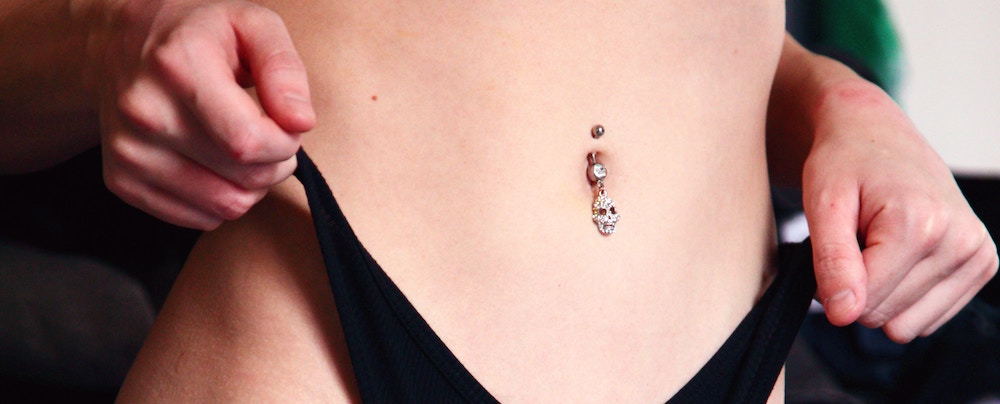
Professional Navel Piercing
The Most Important Step: Is Your Anatomy Suitable for a Navel Piercing?
This is the most critical question, and one that every professional piercer must address before even picking up a needle. A successful, traditional navel piercing is 100% dependent on having the correct anatomy.
Understanding the “Navel Lip” for a Traditional Piercing
A standard navel piercing requires a distinct “lip” or flap of tissue at the top of the navel. This flap must have enough room to support the jewellery so that it can sit comfortably without being pushed or pulled when you move. Crucially, when you sit down and bend, your navel must not collapse or “wink” in a way that puts pressure on the top of the piercing channel.
What Happens if You Pierce Unsuitable Anatomy?
Forcing a traditional piercing into a navel that doesn’t have the right structure is the primary cause of all major navel piercing problems. This will lead to:
- Migration and Rejection: The body will slowly and painfully push the jewellery out of the skin, often leaving a significant scar.
- Severe Irritation and Scarring: Constant pressure from your body’s movement will prevent the piercing from ever healing, causing persistent redness, bumps, and discomfort.
- An Unattractive Result: The jewellery will never sit correctly, often angling outwards or looking strained.
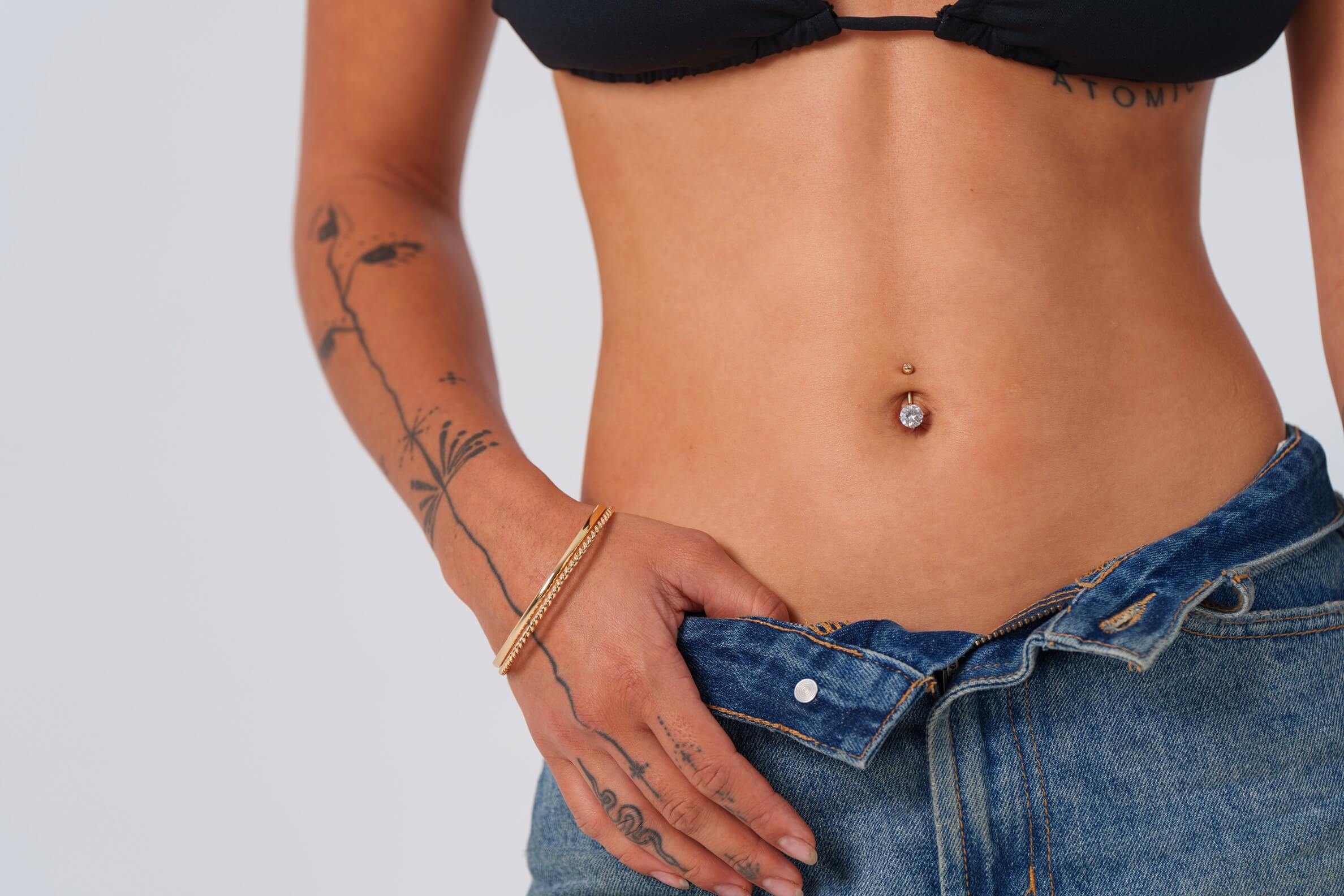
Professional Navel Piercing
Our Honest Assessment Promise
Your safety and the long-term health of your piercing are our primary concerns. During your consultation at Pink Tatpier, the very first thing our expert piercer will do is perform a thorough anatomy assessment, checking your navel both while you are standing and sitting.
If a traditional navel piercing is not a viable or safe option for you, we will be honest and explain exactly why. But that doesn’t mean you can’t have a beautiful navel piercing. It just means you need a modern solution.
The Floating Navel Piercing: A Modern Solution for All Navels
The “floating” navel piercing is an advanced technique specifically designed for individuals whose navels collapse or “wink” when they sit, or for those who don’t have a pronounced navel lip. It has revolutionised navel piercing, making it accessible to many more people.
- How it works: Instead of a traditional barbell with a large gem on the bottom, a floating navel uses a curved barbell with a small, flat disc or a tiny bezel-set gem for the bottom part that sits inside the navel. The decorative, beautiful end is worn on top.
- Why it works: This technique removes the pressure that causes rejection. The small, flat bottom piece doesn’t get pushed outwards when you sit, allowing the piercing to heal successfully in anatomies where a traditional piercing would fail. It creates a beautiful, delicate “floating” look for the top gem.
At Pink Tatpier, we are specialists in this modern technique, allowing us to offer a safe and beautiful navel piercing solution to a much wider range of clients.
The Professional Navel Piercing Process
- Consultation & Anatomy Assessment: This is the critical first step where we determine the correct piercing technique (traditional or floating) for your unique body.
- Jewellery Selection: You will choose your initial jewellery from our collection of implant-grade titanium or solid gold navel curves, specifically designed for safe healing.
- Precise Marking: Your piercer will mark the placement, checking it carefully while you are standing and sitting to ensure it is perfectly aligned and under no pressure when you move.
- The Piercing Procedure: The piercing itself is performed swiftly and hygienically with a sterilised, single-use needle.
- Aftercare Briefing: We provide you with a detailed, comprehensive aftercare plan to guide you through the healing journey.
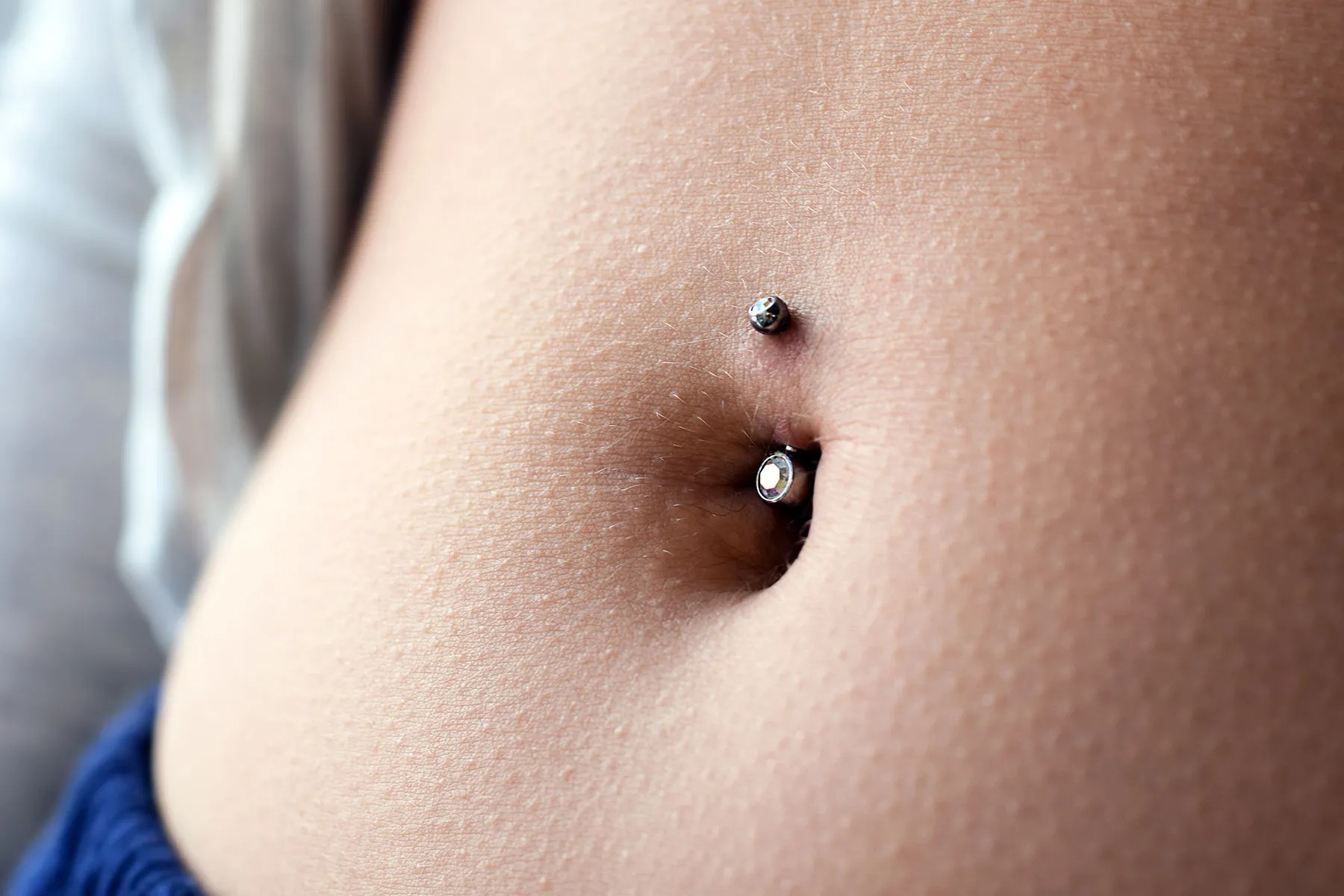
Professional Navel Piercing
Navel Piercing Price, Pain & Healing: Your 2025 London Guide
Pain Level
Most people find a navel piercing to be one of the less painful piercings. On a scale of 1 to 10, it’s typically rated a 4-6. You’ll feel a distinct pressure and a quick pinch, but it’s over in a moment.
Healing Time
This is where commitment is required. Due to its location, constant movement, and friction from clothing, a navel piercing has a long healing time. Expect it to take 9 to 12 months, or sometimes longer, to heal completely. Patience and diligent aftercare are non-negotiable.
Cost of a Navel Piercing in London (as of September 2025)
The price reflects the professional assessment and skill required. Your total cost is the service fee plus the cost of your chosen jewellery.
| Service | Price (GBP) | What’s Included |
| Navel Piercing Service Fee | £45 – £55 | A professional consultation, in-depth anatomy assessment, sterile piercing procedure, and a comprehensive aftercare guide. |
| Initial Jewellery | Starts from £25 | An implant-grade titanium navel curve or floating navel jewellery. Price increases for solid gold or gemstone options. |
| Total Starting Price | From £70 – £80 | The service fee + the cost of your chosen jewellery. |
The Best Jewellery for Your Navel Piercing
For Initial Healing
For the entire initial healing period, the only appropriate jewellery is a simple curved barbell (navel curve) made from high-quality, implant-grade material. The jewellery must be internally threaded or threadless to avoid irritating the healing channel.
For a Healed Piercing
Once your piercing is fully healed (after 9-12 months), you can explore the vast world of decorative navel jewellery, including elaborate curves with dangling gems or charms. Hoops can also be worn in some well-healed navel piercings, but this is highly dependent on anatomy.
Materials Matter
We only use the safest materials for your body:
- Implant-Grade Titanium (ASTM F-136)
- 14k & 18k Solid Gold (Nickel-Free)
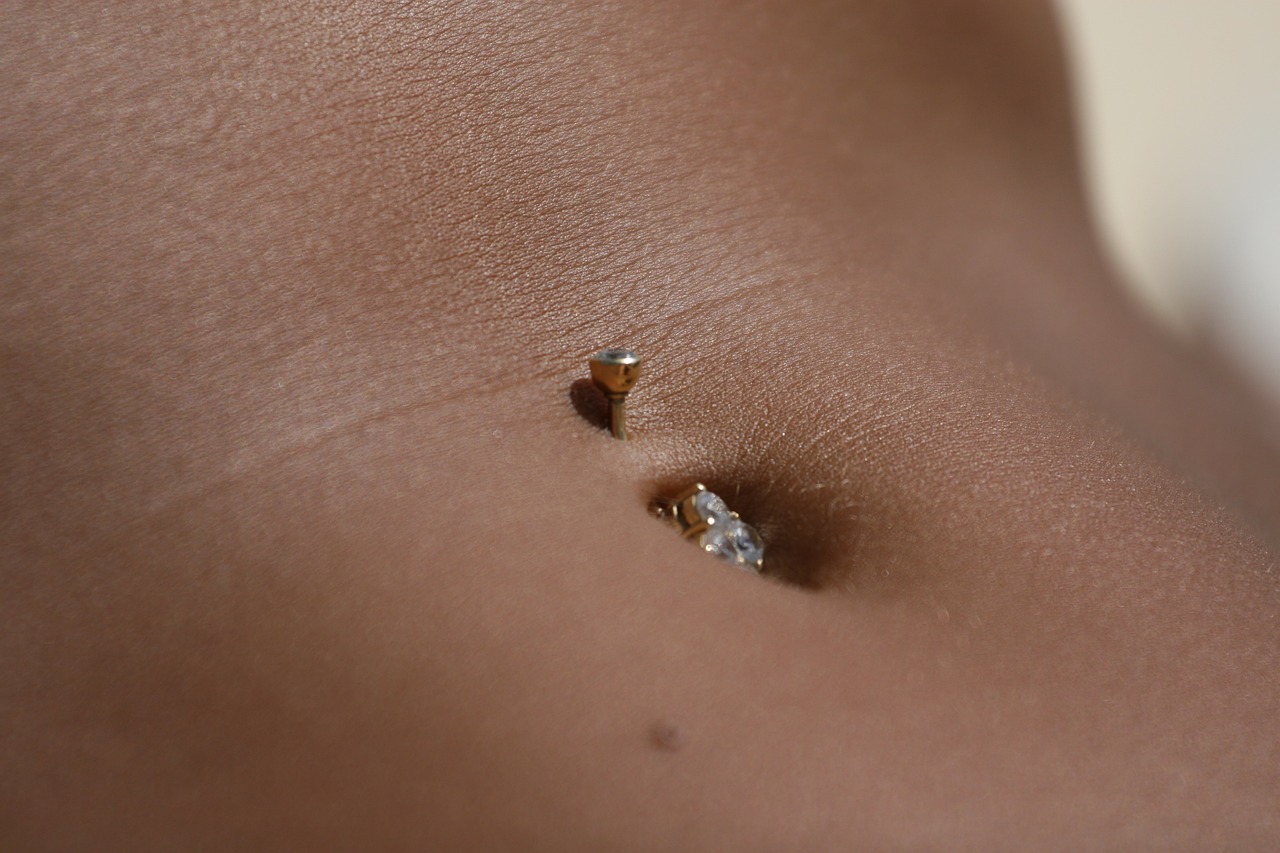
Professional Navel Piercing
The Ultimate Aftercare Guide for a Healthy Navel Piercing
- DO clean the piercing twice daily with a sterile saline solution (we recommend NeilMed Piercing Aftercare spray).
- DON’T wear high-waisted trousers, belts, or tight clothing that puts pressure on or rubs against the piercing. This is the number one cause of irritation and rejection. Opt for low-rise bottoms and loose-fitting tops during healing.
- DON’T sleep on your stomach.
- DON’T go swimming in pools, hot tubs, or the sea for at least the first month, and ideally longer.
- DO NOT twist, turn, or play with the jewellery.
- BE PATIENT! The long healing time is normal. Don’t get discouraged.
Frequently Asked Questions About Navel Piercings
1. Can I get a navel piercing if I have a bigger stomach?
Your weight is not the deciding factor; the shape of your navel when you sit and stand is what matters. Many people, regardless of size, are perfect candidates for a floating navel piercing, which is often a more comfortable and viable option.
2. Can I get pierced if I am pregnant or plan to become pregnant?
We do not pierce anyone who is pregnant. If you become pregnant, it is highly recommended to remove navel jewellery to accommodate your changing body. You can often have it reinserted by a professional after giving birth.
3. What are the signs of rejection vs. normal irritation?
Normal irritation involves some redness and crusting. Rejection is a slow process where you will see the piercing becoming shallower over time, with more of the barbell becoming visible, and the skin between the holes looking thin, red, and angry. If you suspect rejection, see your piercer immediately.
4. When can I change my jewellery to a hoop or a dangly one?
You must wait until the piercing is 100% fully healed. Changing it too early can cause severe irritation and set your healing back months. We can assess your piercing after the 9-12 month mark to confirm if it’s ready.
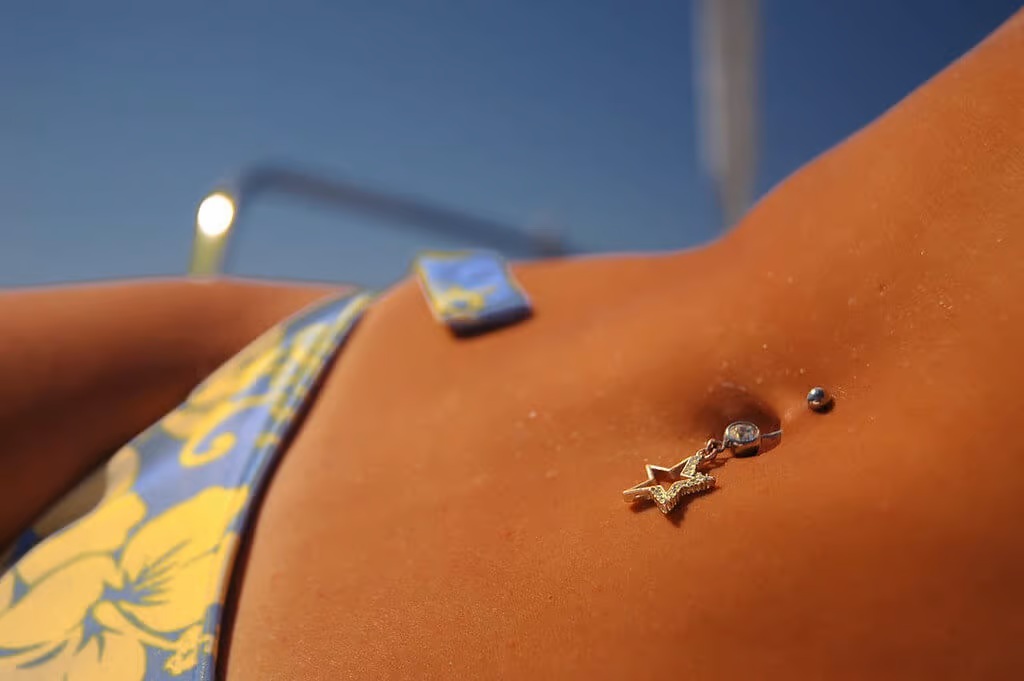
Professional Navel Piercing
Begin Your Journey to a Beautiful Navel Piercing in London
A stunning, well-placed navel piercing is a beautiful accessory. The key to achieving this is to start with a professional who prioritises your unique anatomy and long-term success.

